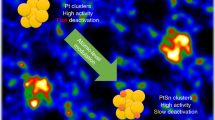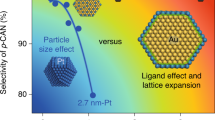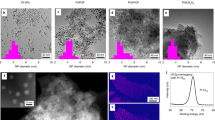Abstract
Colloidal platinum nanoparticles with diameters of 2–5 nm on carbon supports are currently regarded as the best catalysts for the oxygen reduction reaction. However, the particle size is limited by the conventional preparation methods that are used to synthesize small platinum particles; the inherent activity of ultrasmall nanoparticles has not yet been revealed. We present a practical synthesis for ultrafine subnanometre platinum clusters using a spherical macromolecular template with no disorder in molecular weight or structure. The template, a phenylazomethine dendrimer, offers control of the number of metal complexes in an assembly through stepwise complexation, allowing the complexes to accumulate in discrete nano-cages. Subsequent reduction of Pt(IV) chloride to Pt(0) results in the formation of platinum clusters composed of a defined number of atoms. As a result of exceptionally small particle size, the clusters exhibit very high catalytic activity for the four-electron reduction of oxygen molecules.
This is a preview of subscription content, access via your institution
Access options
Subscribe to this journal
Receive 12 print issues and online access
$259.00 per year
only $21.58 per issue
Buy this article
- Purchase on Springer Link
- Instant access to full article PDF
Prices may be subject to local taxes which are calculated during checkout



Similar content being viewed by others
Change history
23 August 2010
In the version of this Article originally published, the descriptions about data analysis of the electrocatalysis in the Methods section were incorrect. This has been corrected in the HTML and PDF versions of the Article.
References
Steele, B. C. & Heinzel, A. Materials for fuel-cell technologies. Nature 414, 345–352 (2001).
Adlhart, C. & Uggerud, E. Reactions of platinum clusters Ptn±, n = 1–21, with CH4: to react or not to react. Chem. Commun. 2581–2582 (2006).
Sun, Y., Zhuang, L., Lu, J., Hong, X. & Liu, P. Collapse in crystalline structure and decline in catalytic activity of Pt nanoparticles on reducing particle size to 1 nm. J. Am. Chem. Soc. 129, 15465–15467 (2007).
Verde, Y. et al. Active area and particle size of Pt particles synthesized from (NH4)2PtCl6 on a carbon support. Catal. Today 107–108, 826–830 (2005).
Raimondi, F., Scherer, G. G., Köz, R. & Wokaun, A. Nanoparticles in energy technology: examples from electrochemistry and catalysis. Angew. Chem. Int. Ed. 44, 2190–2209 (2005).
Ferreira, P. J. et al. Instability of Pt/C electrocatalysts in proton exchange membrane fuel cells. J. Electrochem. Soc. 152, A2256–A2271 (2005).
Yasumatsu, H., Hayakawa, T., Koizumi, S. & Kondow, T. Unisized two-dimensional platinum clusters on silicon(111)-7× surface observed with scanning tunneling microscope. J. Chem. Phys. 123, 124709 (2005).
Alayan, R. et al. Morphology and growth of metal clusters in the gas phase: A transition from spherical to ramified structures. Phys. Rev. B 73, 125444 (2006).
Astruc, D., Lu, F. & Aranzaes, J. R. Nanoparticles as recyclable catalysts: the frontier between homogeneous and heterogeneous catalysis. Angew. Chem. Int. Ed. 44, 7852–7872 (2005).
Zhao, M., Sun, L. & Crooks, R. M. Preparation of Cu nanoclusters within dendrimer templates. J. Am. Chem. Soc. 120, 4877–4878 (1998).
Balogh, L. & Tomalia, D. A. Poly(amidoamine) dendrimer-templated nanocomposites. 1. Synthesis of zerovalent copper nanoclusters. J. Am. Chem. Soc. 120, 7355–7356 (1998).
Zheng, J., Petty, J. T. & Dickson, R. M. High quantum yield blue emission from water-soluble Au8 nanodots. J. Am. Chem. Soc. 125, 7780–7781 (2003).
Ye, H. & Crooks, R. M. Electrocatalytic O2 reduction at glassy carbon electrodes modified with dendrimer-encapsulated Pt nanoparticles. J. Am. Chem. Soc. 127, 4930–4934 (2005).
Ye, H. & Crooks, R. M. Effect of elemental composition of PtPd bimetallic nanoparticles containing an average of 180 atoms on the kinetics of the electrochemical oxygen reduction reaction. J. Am. Chem. Soc. 129, 3627–3633 (2007).
Lang, H., May, R. A., Iversen, B. L. & Chandler, B. D. Dendrimer-encapsulated nanoparticle precursors to supported platinum catalysts. J. Am. Chem. Soc. 125, 14832–14836 (2003).
Esumi, K., Isono, R. & Yoshimura, T. Preparation of PAMAM- and PPI-metal (silver, platinum, and palladium) nanocomposites and their catalytic activities for reduction of 4-nitrophenol. Langmuir 20, 237–243 (2004).
Yamamoto, K., Higuchi, M., Shiki, S., Tsuruta, M. & Chiba, H. Stepwise radial complexation of imine groups in phenylazomethine dendrimers. Nature 415, 509–511 (2002).
Yamamoto, K. & Imaoka, T. Dendrimer complexes based on fine-controlled metal assembling. Bull. Chem. Soc. Jpn 79, 511–526 (2006).
Hecht, S. & Fréchet, J. M. J. Dendritic encapsulation of function: applying nature's site isolation principle from biomimetics to materials science. Angew. Chem. Int. Ed. 40, 74–91 (2001).
Weyermann, P., Gisselbrecht, J., Boudon, C., Diederich, F. & Gross, M. Dendritic iron porphyrins with tethered axial ligands: new model compounds for cytochromes. Angew. Chem. Int. Ed. 38, 3215–3219 (1999).
Enoki, O., Katoh, H. & Yamamoto, K. Synthesis and properties of a novel phenylazomethine dendrimer with a tetraphenylmethane core. Org. Lett. 8, 569–571 (2006).
Imaoka, T., Tanaka, R. & Yamamoto, K. Investigation of a molecular morphology effect on polyphenylazomethine dendrimers; physical properties and metal-assembling processes. Chem. Eur. J. 12, 7328–7336 (2006).
Higuchi, M., Shiki, S., Ariga, K. & Yamamoto, K. First synthesis of phenylazomethine dendrimer ligands and structural studies. J. Am. Chem. Soc. 123, 4414–4420 (2001).
Dükers, K., Prince, K. C., Bonzel, H. P., Chá, V. & Horn, K. Adsorption-induced surface core-level shifts of Pt(110). Phys. Rev. B 36, 6292–6301 (1987).
Peuckert, M. & Bonzel, H. P. Characterization of oxidized platinum surfaces by X-ray photoelectron spectroscopy. Surf. Sci. 145, 239–259 (1984).
Eberhardt, W. et al. Photoemission from mass-selected monodispersed Pt clusters. Phys. Rev. Lett. 64, 780–783 (1990).
You, T. et al. Co-sputtered thin film consisting of platinum nanoparticles embedded in graphite-like carbon and its high electrocatalytic properties for electroanalysis. Chem. Mater. 14, 4796 (2002).
Yoshitake, H., Mochizuki, T., Yamazaki, O. & Ota, K. Study of the density of the d-state and structure transformation of Pt fine particles dispersed on carbon electrodes by in-situ X-ray-absorption spectroscopy. J. Electroanal. Chem. 361, 229–237 (1993).
Yoshitake, H., Yamazaki, O. & Ota, K. In-situ X-ray-absorption fine-structure study on structure transformation and electronic-state of various Pt particles on carbon electrode. J. Electrochem. Soc. 141, 2516–2522 (1994).
Enoki, O., Imaoka, T. & Yamamoto, K. One-step synthesis of a platinum nanoparticle with carbon materials using a phenylazomethine dendrimer as a template. Bull. Chem. Soc. Jpn 79, 621–626 (2006).
Huang, M. et al. Alternate assemblies of platinum nanoparticles and metalloporphyrins as tunable electrocatalysts for dioxygen reduction. Langmuir 21, 323–329 (2005).
Zhang, J., Sasaki, K., Sutter, E. & Adzic, R. R. Stabilization of platinum oxygen-reduction electrocatalysts using gold clusters. Science 315, 220–222 (2007).
Huang, W. et al. Dendrimer templated synthesis of one nanometre Rh and Pt particles supported on mesoporous silica: catalytic activity for ethylene and pyrrole hydrogenation. Nano Lett. (2008).
Jiang, R. & Dong, S. Rotating ring disk electrode (RRDE) theory dealing with nonstationary electrocatalysis: study of the electrocatalytic reduction of dioxygen at cobalt protoporphrin modified electrode. J. Phys. Chem. 94, 7471–7476 (1990).
Shi, C. & Anson, F. C. (5, 10, 15, 20-Tetramethylporphyrinato)cobalt(II): A Remarkably Active Catalyst for the Electroreduction of O2 to H2O. Inorg. Chem. 37, 1037–1043 (1998).
Toda, T., Igarashi, H., Uchida, H. & Watanabe, M. Enhancement of the electroreduction of oxygen on Pt alloys with Fe, Ni, and Co. J. Electrochem. Soc. 146, 3750–3756 (1999).
Stamenkovic, V. et al. Changing the activity of electrocatalysts for oxygen reduction by tuning the surface electronic structure. Angew. Chem. Int. Ed. 45, 2897–2901 (2006).
Ramallo-Lopez, J. M. et al. XPS and XAFS Pt L-2, L-3-edge studies of dispersed metallic Pt and PtSn clusters on SiO2 obtained by organometallic synthesis: Structural and electronic characteristics. J. Phys. Chem. B 107, 11441–11451 (2003).
Rodriguez, J. A., Chaturvedi, S., Jirsak, T. & Hrbek, J. Reaction of S2 and H2S with Sn/Pt(111) surface alloys: Effects of metal-metal bonding on reactivity towards sulfur. J. Chem. Phys. 109, 4052–4062 (1998).
Satoh, N., Nakashima, T., Kamikura, K. & Yamamoto, K. Quantum size effect in TiO2 nanoparticles prepared by finely controlled metal assembly on dendrimer templates. Nature Nanotech. 3, 106–111 (2008).
Ye, H., Crooks, J. A. & Crooks, R. M. Effect of particle size on the kinetics of the electrocatalytic oxygen reduction reaction catalyzed by Pt dendrimer-encapsulated nanoparticles. Langmuir 23, 11901–11906 (2007).
Acknowledgements
This work was partially supported by CREST from the Japan Science and Technology Agency, and a Grants-in-Aid for Scientific Research (Nos. 19205020, 19022034) from the Ministry of Education, Culture, Sports, Science and Technology, Japan. The XAFS measurements were performed under the approval of the Photon Factory Program Advisory Committee (Proposal No. 2007G160).
Author information
Authors and Affiliations
Contributions
O.E., H.K. and M.T. prepared clusters and modified electrodes. M.T. and T.I. carried out electrochemical measurements. W.C., T.I. and A.S. carried out XAFS experiments. W.C. analysed the EXAFS spectra. T.I. H.K. and K.Y. conceived experiments, designed experimental procedures and co-wrote the manuscript. K.Y. directed the research.
Corresponding author
Supplementary information
Supplementary information
Supplementary information (PDF 3187 kb)
Rights and permissions
About this article
Cite this article
Yamamoto, K., Imaoka, T., Chun, WJ. et al. Size-specific catalytic activity of platinum clusters enhances oxygen reduction reactions. Nature Chem 1, 397–402 (2009). https://doi.org/10.1038/nchem.288
Received:
Accepted:
Published:
Issue Date:
DOI: https://doi.org/10.1038/nchem.288
This article is cited by
-
Advanced electrochemical techniques for characterizing electrocatalysis at the single-particle level
Carbon Neutrality (2023)
-
Theoretical investigation of copper clusters using the electron propagator theory
Journal of Chemical Sciences (2023)
-
Size-engineered noble metal nanoclusters synthesized by impregnation for size-dependent catalysis
Science China Materials (2023)
-
Functionalization of phenylazomethine dendrimers
Polymer Journal (2022)
-
Recent Advancement in Pd-Decorated Nanostructures for Its Catalytic and Chemiresistive Gas Sensing Applications: A Review
Topics in Catalysis (2022)



